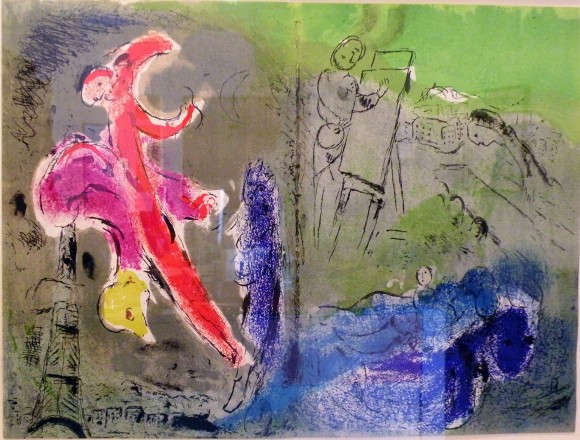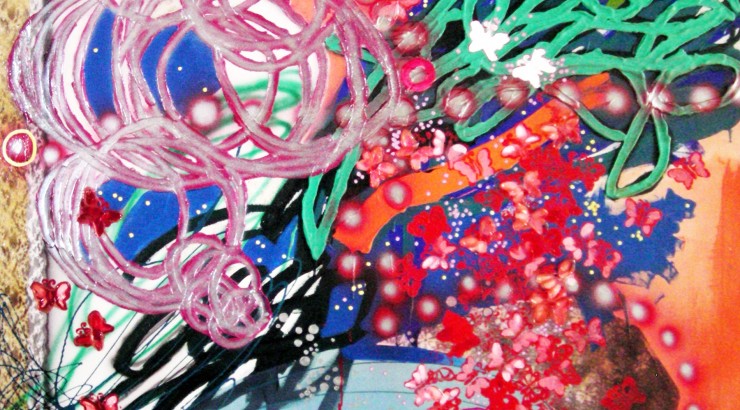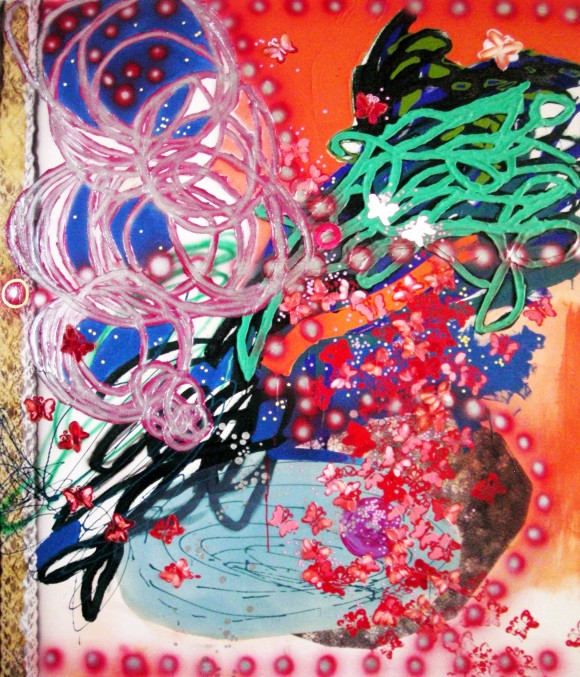Expressionism An artistic movement and an art term?
March 28, 2016

Marc Chagall, “Vision of Paris”, Lithograph, 1952- Although he was associated with many different movements, Chagall is one of the most famous expressionist painters.
Expressionism is an artistic style that emerged simultaneously throughout Germany in the late 19th century and continued into the early 20th century, partially in response to a phenomenon called “fin de siecle,” which means “end of the century” in French. Not unlike when people in the 1990s were afraid that computers were going to stop working when the 2000s came, a lot of people at the end of the 19th century felt anxiety about the uncertainty of turning over into the 20th century. A group of artists that became associated with the Expressionism movement, tried to express or capture these feelings of uncertainty through swirling, exaggerated brushstrokes or jarring and violent lines and combinations of colors. One of the most famous paintings from early on in this movement is The Scream by Edvard Munch (1893). In The Scream, the blood-red color of the sky, the dizzying bands of color, and the distorted screaming figure create a sense of intense anxiety and unease.

Roger Herman, “Building”, Oil on Canvas, 1996- Herman’s work can be described as “Neo-Expressionist” referring to the movement that emerged during the 80s which returned to expressive colors and recognizable forms as a reaction to the modern and minimalist movements before it.
Expressionism was an extremely important movement because it worked to change the purpose and standards of art for the rest of art history. Rather than trying to accurately represent the world, as artists had been doing since the Renaissance, Expressionist artists sought to express their subjective inner emotions, fantasies, or thoughts independent from “reality”. In this way, Expressionism can be seen as a rejection of the Impressionism movement that came before it and a precursor to Abstract art. The difference between Expressionism and Abstract art is that expressionistic art does not necessarily abandon all figural or representational elements, although it can use elements of abstraction, or “weak abstraction,” to create an emotional effect. Expressionism that is fully abstract, or exhibits “strong abstraction” (meaning that it no longer bears any resemblance to anything in the outside world and is completely generated by the artist’s imagination) is called Abstract Expressionism and was an artistic movement during the 1940s… but that’s a whole other story!
The works of the artists during the Expressionism movement are extremely varied in color, subject-matter, and painting style. There were even several different movements within the Expressionism movement that had different goals and artists. So although Expressionism is used to describe an artistic movement, it is really more of a general term used to describe a style of art that exists in today’s art world as much as it did in the 19th century. The term “expressionism” is used to refer to artworks that place a particular emphasis on emotional content. In expressionistic works, strong emotion can be conveyed either thematically or through means of technique and medium. This is similar to how there was an Abstract Art movement, but we use the term “abstract” to describe all kinds of works of art from a range of different time periods.

Victor Hugo Zayas, Lluvia. Oil on Canvas, 2004- Zayas paints his landscapes with expressive colors and brush strokes, conveying an emotional and moody atmosphere.
The Escalette Collection has a multitude of paintings that certainly fall under the term “expressionism” and “abstraction”. One excellent example is Ellina Kevorkian‘s Last Night My Tears Were Falling, I Went To Bed So Sad And Blue, Then I Had a Dream Of You (2002) located on the fourth floor of Beckman. The seemingly infinite groupings of brushstrokes, the bright colors, and the use of different mediums create a sense of exaggerated femininity and playfulness. We, at the Escalatte Collection, invite you to walk the halls of Beckman and experience expressionism for yourself! Can you describe the emotion that each work is trying to create?




